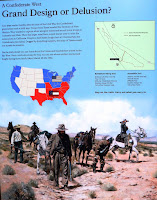 The park was located down in a canyon along the Pecos River, it was a very interesting beautiful drive
down a two lane road along the river to the park. What I did not realize was
that once you got down into the canyon there was no phone service, no internet
service or any type of TV service, local or via satellite as the cliff blocked
all. This turned into one of the most peaceful, relaxing week we had on our trip
though. The park was beautiful with trails down the river.
The park was located down in a canyon along the Pecos River, it was a very interesting beautiful drive
down a two lane road along the river to the park. What I did not realize was
that once you got down into the canyon there was no phone service, no internet
service or any type of TV service, local or via satellite as the cliff blocked
all. This turned into one of the most peaceful, relaxing week we had on our trip
though. The park was beautiful with trails down the river. 

Our visit to the Pecos National Historical Park was more than I had expected. I was looking for the Glorieta Battlefield (where a battle during the civil war took place) but also found the park consisted of several Puebloan sites, Santa Fe Trail ruts and the old Kozlowski’s Stage Stations which was a tavern and watering stop
on the Santa Fe Trail.
The ruins at the visitor center is a location where some of the first Puebloans around 1100 started building their rock and mud villages. Over two dozen villages were built over the area during the next two centuries. The area grew and more than 2000 Pueblo Indians lived there during its history as they moved in closer together due to the increase of the plain Indians. The villages were built up on the mountain top so they could better see any
enemies advancing upon them. Storage areas for food was built under ground in what was called kivas; many of the kivas were also used as ceremonial kivas. With the introduction of the Franciscan priest, they were taught how to cultivate the land and the priest also had them build some of the most impressive mission in the area. One of these were in the ruins and was one of the most imposing in New Mexico, with towers, buttresses and great pine long beams that were hauled from the mountains.
When silver was discovered and the struggles between the church and civil officials emerged for the Indian laborer, loyalty from the Indians started to suffer and they started fighting to take back their land and send the Spaniard back to Mexico destroying the missions and all that the Spaniards had them built. In taking control of the missions the Indians showed their discontent and built a forbidden kiva in the mission’s convento itself.
Walking through the ruins of what was once a great village was interesting. The history that you are taught while young and in school does not come close the the reality of what you see in these different places and looking upon the land. Taking the time to sit and just listen to the land and look from where we came is amazing and it makes you wonder why we don’t appreciate it more. History has a way of repeating itself and we really need to take the time to look and listen to the lessons of our ancestors so we do not make the same mistakes they did in letting outsiders come in and take control. Okay enough of my personal opinions. Here are more pictures of the ruins, hope you enjoy.

On the flip side of this National park was the Glorieta Battleground. This battle has been described as the west version of the Gettysburg Battle during the Civil War. I was personally disappointed in what we saw. The battle took place March 26-26, 1862 and really was a indecisive battle as neither side won or lost. In short the confederates made plans to raise a force of Texans and invade New Mexico to capture military supplies from Union forts in New Mexico. They had also hopes to recruit the miners in the area to the Confederacy and then they could take the ports in California and the South would then have a blockade free international trade. The Union found out about the plans and had the governors of New Mexico and Colorado to organize volunteers to assist in stopping the Confederates. Essentially what happen as both sides found out about each other and the battle began they destroying each others supplies and blocking the supply routes therefore neither were able to get supplies, food and/or other necessary items needed. As supplies ran out and the men grew tired, two weeks after the last battle both sides retreated back to their respective forts.
The area of the battle now is overgrown but there are hiking trails through the battlefield for those that want to take them. You must first visit the Visitor Center at thee ruins so that you can get the code to enter the area though. There is a 2.25 mile trail around the field and a short 1/2 mile round trip trail for those that just want to get an idea of the area.

There is a landmark that has been placed in memory of those soldiers who lost their life during the battle. Again you have to asked about its location and it is a drive from the park to find. I was disappointed in the care and preservation of this battle and the battleground, but was glad that we went.










No comments:
Post a Comment